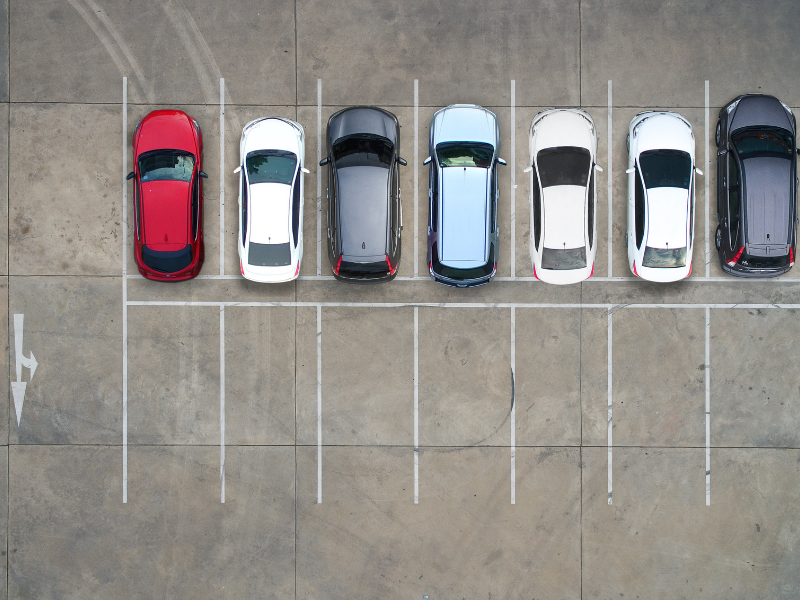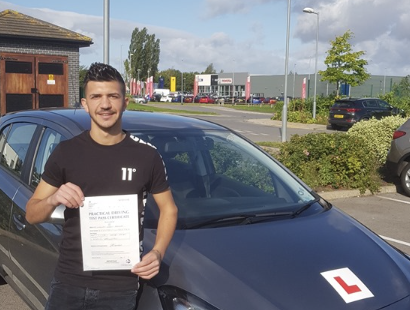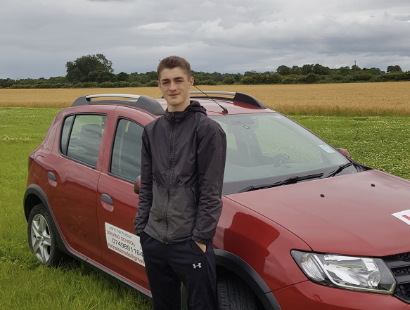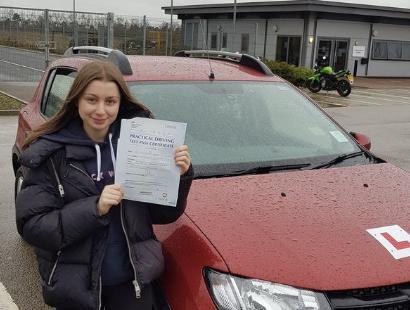Are you preparing for your driving test and eager to conquer the challenging driving test manoeuvres?
Look no further!
This blog post is designed to help you master the essential vehicle control actions that will pave the way to getting your driving licence.
We will answer common questions such as:
In this comprehensive blog post, we will guide you step-by-step through the process, ensuring you gain the necessary skills and confidence to pass your driving test with flying colors.
So, let’s jump in so you know what to expect on your practical driving test.
And if you want a bit more help, claim a learner driver checklist today.
LEARN THE TEST ROUTES FOR YOUR AREA HERE

One common concern among learner drivers is whether they can fail their driving test solely based on their performance during a manoeuvre.
So, let’s address this question.
The short answer is yes, it is possible to fail your driving test if you struggle with a manoeuvre. The driving test assesses your overall ability to drive safely and confidently, which includes demonstrating competence in various manoeuvres.
Failing to execute a manoeuvre correctly may result in critical errors that could lead to a test failure.
However, you should understand that a single mistake or struggle with a manoeuvre doesn’t automatically guarantee failure. The driving test examiners evaluate your overall driving performance, including:
They take note of these throughout the entire test.
While manoeuvres are important to know, they are just one component of the evaluation process.
The key to success lies in thorough preparation and practice.
By focusing on mastering the essential driving test manoeuvres we discussed earlier, you increase your chances of performing well during the test.
So, practice these road movements in various scenarios, such as different types of:
It will build confidence in your car handling tasks, leading to a higher chance of passing your exam.
During the test, remember to stay calm and composed. Even if you encounter challenges during a manoeuvre, you need to demonstrate good judgement, observation, and proper reaction to minimise errors.
Examiners take into account your overall performance and your ability to recover from mistakes.
You need to not only know the maneuvers, but, understand the purpose behind each. By grasping the underlying principles and practicing the correct techniques, you’ll be better equipped to navigate through the manoeuvres successfully.
Finally, don’t forget the importance of road safety. While performing manoeuvres, ensure that you prioritise safety, adhere to traffic rules, and remain aware of your surroundings.
So, while it is possible to fail your driving test due to struggles with manoeuvres, you need to learn them so you are prepared.
To equip you with the necessary skills, we have compiled a list of the top 5 must-know driving test manoeuvres.
Let’s explore each one in detail:
The cockpit drill, a fundamental aspect of safe driving, sets the stage for your success on the road.
By adjusting your mirrors, seat position, and familiarising yourself with the vehicle’s controls, you ensure optimal visibility and comfort while driving, ultimately increasing your chances of passing the driving test.

Mastering the skill of bay parking, specifically parking your car within the designated white lines while attentively observing other road users, is of utmost importance when preparing for a driving test.
Being knowledgeable and proficient in this aspect not only ensures a smoother driving experience but also enhances safety on the road for both yourself and others.
Bay parking is a fundamental maneuver that involves parking your vehicle within a designated bay or parking space.
It is commonly encountered in parking lots, shopping centers, and other areas where vehicles are required to be parked in an organized manner.
The ability to perform this maneuver accurately and efficiently demonstrates your control over the vehicle and your awareness of the surrounding environment.
When bay parking, you can take a systematic approach to maximise your chances of success. This typically involves the following steps:
Remember, mastering bay parking not only contributes to your success in passing the driving test but also plays a vital role in real-world driving scenarios.
The ability to park efficiently within the designated lines ensures efficient use of parking spaces, minimises inconvenience to other drivers, and promotes a smoother flow of traffic.
Additionally, being observant of other road users during the maneuver showcases your attentiveness and consideration for the safety of others.
Investing time and effort into learning how to bay park proficiently demonstrates your commitment to becoming a responsible and skilled driver.
So, take advantage of the resources provided, practice the maneuver diligently, and strive to excel in bay parking to ensure a confident and successful driving test experience, as well as a safe and enjoyable journey on the road.

Parallel parking refers to the process of parking a vehicle parallel to the kerb, between two parked cars, or within a designated parking space on the side of the road.
This manoeuvre is commonly encountered in urban areas, busy streets, and areas with limited parking options.
Proficiency in reverse parking demonstrates your ability to manoeuvre your vehicle accurately and safely in tight spaces, ensuring efficient use of parking areas and maintaining a smooth flow of traffic.
While reverse parking may seem complicated at first, it can be broken down into a systematic approach that simplifies the process.
The following steps are typically involved in reverse parking.
Positioning: Select a suitable spot to park, ensuring there is enough space for your vehicle.
Signal your intention to park and position your car parallel to the vehicle in front of the desired parking space, leaving a safe distance.
Observation: Before proceeding with the manoeuvre, thoroughly observe your surroundings. Check for pedestrians, cyclists, and other vehicles approaching or occupying the area.
Use your mirrors and blind spots to ensure it is safe to proceed.
Steering and Reverse: Begin by turning the steering wheel fully to the right (or left, depending on the side of the road you drive on) while shifting your vehicle into reverse gear.
Slowly release the brake and control the speed using the accelerator.
Angle and Mirrors: As you begin to reverse, monitor the angle of your vehicle by checking your side mirrors and rear-view mirror.
Adjust the steering wheel to maintain a proper angle while keeping a safe distance from the parked cars.
Reference Points: Utilise reference points, such as the position of your vehicle in relation to the parked cars or the kerb, to guide your manoeuvre.
These points assist in aligning your vehicle parallel to the kerb and within the designated parking space.
Final Adjustments: Once your vehicle is positioned correctly within the parking space, straighten your wheels by turning the steering wheel back to its original position.
Ensure you leave adequate space between your vehicle and the surrounding cars.
Parking Brake: Engage the parking brake to secure your vehicle in place.

An emergency stop is a sudden and forceful braking action used to swiftly bring the vehicle to a stop in an unexpected or hazardous situation.
It may be required to avoid collisions with pedestrians, animals, or other vehicles that suddenly enter your path.
By practising and understanding the proper technique for an emergency stop, you can effectively respond to such situations, potentially preventing accidents and ensuring the safety of yourself and others on the road.
During a driving test, your ability to perform an emergency stop will be assessed by the examiner.
They will evaluate your reaction time, braking technique, control of the vehicle, and the ability to stop the car promptly and safely.
Therefore, it is crucial to familiarise yourself with the correct procedure for carrying out an emergency stop in order to increase your chances of passing the driving test.
To execute a well-controlled emergency stop, the following steps are typically involved:
Observation and Decision: Remain vigilant and scan the road ahead for any potential hazards. When confronted with an emergency situation, quickly assess the need for an emergency stop and make a decisive decision to apply the brakes.
Signal and Communication: Alert other road users by activating the hazard lights and ensure they are aware of your intention to make an emergency stop.
Braking Technique: Apply firm and progressive pressure to the brake pedal with your right foot. Maintain control of the steering wheel and avoid locking the wheels, which could lead to skidding.
Balance and Control: As you brake, shift your body weight slightly forward to maintain balance and stability. Keep both hands on the steering wheel to ensure control of the vehicle.
Stop and Assess: Bring the vehicle to a complete stop as quickly and safely as possible, without skidding or losing control. Once stopped, assess the situation and proceed accordingly.

Mastering the skill of forward bay parking, which involves driving forward into a parking bay and then reversing out, is an important ability for drivers to acquire.
While it may seem straightforward, this UK conductor action can pose challenges for new drivers and catch them off guard if not performed correctly.
Forward bay parking is a common parking technique used in various locations such as local car parks, shopping centres, and car parks.
It requires driving your vehicle into a designated parking bay, positioning it correctly within the lines, and subsequently reversing out when leaving.
While forward bay parking may initially appear deceptively simple, it can be broken down into a systematic approach to ensure accuracy and efficiency.
The following steps are typically involved:
Approach: Choose an appropriate entry position aligned with the centre of the parking bay and begin moving forward slowly.
Observation: Before proceeding further, carefully observe your surroundings, including other vehicles, pedestrians, and any potential obstacles that may affect your parking. Ensure it is safe to continue.
Positioning: Align your vehicle parallel to the parked cars on either side of the bay, leaving sufficient space on both sides.
Progress: Gradually drive forward into the bay, maintaining a slow and controlled speed. Monitor your position in relation to the lines of the bay and adjust as necessary.
Alignment: Once positioned within the bay, ensure your vehicle is centred and aligned correctly between the white lines. Use your mirrors and rear-view camera (if available) to assist you.
Final Adjustments: Make any necessary adjustments to ensure your vehicle is parked within the lines, leaving equal space on either side. Double-check your position and correct as needed.
Reversing Out: When ready to leave the bay, check your surroundings again for any approaching vehicles or pedestrians. Reverse out slowly, keeping a close eye on your mirrors and blind spots.
Once you have grasped these essential road test movements, you’ll be ready to tackle more advanced driving skills.
With a structured plan and dedicated practice, you can build upon your foundation and master additional aspects, such as:
Each step will enhance your driving abilities, ensuring a well-rounded skill set.
Congratulations on taking the first step toward becoming a confident and skilled driver.
You’re setting yourself up for success on your driving test by learning the essential vehicle control exercises.
[et_pb_section fb_built="1" theme_builder_area="post_content" _builder_version="4.20.4" _module_preset="default"][et_pb_row _builder_version="4.20.4" _module_preset="default" theme_builder_area="post_content"][et_pb_column _builder_version="4.20.4" _module_preset="default" type="4_4" theme_builder_area="post_content"][et_pb_text _builder_version="4.20.4" _module_preset="default" theme_builder_area="post_content" hover_enabled="0" sticky_enabled="0"]Can you learn to drive in a month? Absolutely, you can!
With commitment and the right guidance, obtaining your driving licence in this time frame is attainable.
However, it requires continuous practice and determination to become an accomplished driver.
Let's guide you through the necessary steps.
The first step to learning how to drive in a month involves securing a provisional licence.
This straightforward process typically concludes in about 10 days.
You can apply online or via a D1 form available at post offices.
Ensure you have the necessary documents like proof of identity and residence.
If you need help, read my guide on applying for a provisional driving licence.
Subsequently, you need to pass a theory test. Resources like the Thorn Test Kit and Driving Test Success are designed to help you understand the Highway Code.
Eight days of thorough study should equip you well for this test.
Now, what materials should you study? I recommend the theory test kit.
I will give you loads of information and new ways of studying.
You can grab the test kit using the red button below.
[/et_pb_text][et_pb_button button_text="Get the Official DVSA Theory Test Kit" _builder_version="4.20.4" _module_preset="default" theme_builder_area="post_content" button_url="https://www.amazon.co.uk/UK-Driving-Theory-Test-Kit/dp/B09D84M7C4?crid=YR6B1HZ4PLT0&keywords=theory+test+2022&qid=1667663645&sprefix=theory+test+2022,aps,100&sr=8-1-spons&psc=1&linkCode=sl1&tag=johnnicholson-21&linkId=7ea476413d22d92b58195fd14b0f28ac&ref_=as_li_ss_tl" custom_button="on" button_text_color="#FFFFFF" button_bg_color="#E02B20" button_bg_enable_color="on" button_alignment="center" hover_enabled="0" sticky_enabled="0"][/et_pb_button][et_pb_text _builder_version="4.20.4" _module_preset="default" theme_builder_area="post_content" hover_enabled="0" sticky_enabled="0"]Or, you could read more about the theory test kit to learn how it will become an invaluable resource for you!
Following the theory test, you need to exhibit hazard perception skills.
The Driving Test Success app provides interactive videos simulating real-life driving.
Regular usage of this app should enhance your hazard perception abilities.
I recommend this to all my students in addition to the theory test kit because it focuses on the hazard perception test in a way that most preparation materials do not.
You will gain access to many hours of hazard test perception meaning on test day, you are ready.
Before getting behind the wheel, it's critical to acquire learner driver insurance.
This coverage protects you while you're learning.
Without it, you risk a driving ban before obtaining your licence.
Research various insurance providers and compare quotations to find the most suitable deal.
You could use a platform like compare the market, but I always find their insurance prices to be a bit higher than other platforms.
And, they usually avoid smaller insurance companies that will save you loads of money.
[/et_pb_text][et_pb_code _builder_version="4.20.4" _module_preset="default" theme_builder_area="post_content" hover_enabled="0" sticky_enabled="0"]Once you have a provisional licence, identify suitable practice locations.
Practice with a parent or an approved driving instructor in low-traffic areas like vacant car parks or quiet residential streets.
As you gain confidence, challenge yourself with busier roads.
Many driving schools offer designated practice areas replicating test conditions.
Just keep in mind that as a learner driver you need to avoid motorways.
You cannot legally drive on a motorway without a full driving licence.
Keep that in mind as you are preparing for your test.
Need a bit more help looking for practice spots? Read about the best places to practice driving in the UK.
After adequate practice, it's time to book your practical driving test.
Limited slots at test centres can pose a challenge.
Booking well in advance helps secure a slot.
If you need an urgent slot, the Driving Test Cancellation App notifies you about cancellations.
The app is a great way to get your licence faster because it pulls data from testing centres.
The gov.uk website often fails to update immediately, so you may be missing available slots.
Learn more about the driving test cancellation app and its benefits.
I'm sure you will find it a valuable resource!
Can you learn to drive in a month?
Yes, but it's important to remember, continuous practice moulds a proficient driver.
Seize every opportunity to improve your driving. Here are some additional tips:
Structured Lessons: Consider professional driving lessons. Approved instructors teach advanced techniques, ensuring you're ready for the practical test.
Night Driving: Once comfortable, include night driving in your practice.
This brings different challenges and helps you adjust.
Road Types and Traffic Conditions: Practise on diverse road types and traffic conditions.
This familiarises you with various scenarios, aiding decision-making.
Defensive Driving: Master defensive driving techniques.
Being vigilant, anticipating hazards, and maintaining safe distance can prevent accidents.
Mock Tests: Take mock driving tests to gauge progress.
These tests mirror the actual exam, helping pinpoint areas requiring improvement.
[/et_pb_text][et_pb_image src="https://johnnicholsondrivingschool.co.uk/wp-content/uploads/2023/07/Can-you-learn-to-drive-in-a-month-Yes-with-driving-practice-you-can.-2.png" _builder_version="4.20.4" _module_preset="default" theme_builder_area="post_content" alt="Can you learn to drive in a month? Yes, with driving practice you can. " title_text="Can you learn to drive in a month? Yes, with driving practice you can. -2" hover_enabled="0" sticky_enabled="0"][/et_pb_image][et_pb_text _builder_version="4.20.4" _module_preset="default" theme_builder_area="post_content" hover_enabled="0" sticky_enabled="0"]Can you learn to drive in a month?
Certainly, with dedicated practice and the right resources.
Follow the outlined steps:
Stay patient and embrace the learning journey.
Safety and responsibility should be your priorities.
Following this guide and committing to regular practice will set you on the right path to becoming a licensed driver.
Remember to obtain a quote for learner driver insurance and utilise the resources highlighted in this post.
They'll support you on your journey to becoming a skilled driver. Good luck!
[/et_pb_text][/et_pb_column][/et_pb_row][/et_pb_section]If you’re learning to drive, you need learner driver insurance!
Learning to drive is an exciting milestone in life, but before you take the wheel, you need learner driver insurance.
In this comprehensive guide, we will delve into:
By reading this post, you will ensure your safety and legality on the road.

Driving as a learner carries inherent risks, and accidents can happen to anyone.
So a special policy provides a crucial layer of protection that shields both the learner and others on the road.
It offers financial coverage in the event of damage, theft, or injury, easing the burden of unexpected expenses and potential legal consequences.
This act is taken very seriously by authorities in the UK. Continue reading to learn about the penalties involved.
Driving without special learner insurance will result in the invalidation of your insurance policy. Not only does this leave you financially exposed in case of accidents or damage, but it can also lead to higher insurance premiums in the future.
You can receive penalty points on your licence if you don’t have learner insurance. These points can accumulate and remain on your record even after you pass your driving test.
Exceeding the allowed number of penalty points can ultimately lead to disqualification from driving.
Driving without the necessary insurance can result in a substantial fine.
The penalty for this offense can reach up to £1,000, imposing a significant financial burden in addition to the risks associated with being uninsured.
Accumulating a certain number of penalty points due to driving without insurance can lead to a court summons and potentially a temporary driving ban.
Learning to drive without insurance will leave a mark on your driving record.
Considering the potential consequences, it is crucial to prioritise getting the right policy and coverage!

You might be concerned about the associated costs of getting insurance made for learner drivers.
However, it doesn’t have to break the bank.
You can easily access a wide range of insurance providers across the UK with many online platforms.
These platforms enable you to compare quotes and find a policy that fits your needs and budget.
With just a few clicks, you can access a wealth of options, compare prices, and choose the coverage that suits your requirements…
All while ensuring that you are safe and legal on the road.
What are you waiting for?
Getting insurance is an essential step before embarking on your journey as a new driver.
It not only protects you and others but also provides financial security and peace of mind.
Remember, driving without insurance can lead to severe consequences, both legally and financially.
I recommend confused.com for finding a policy that fits your needs and budget, ensuring a safe and legal driving experience.
Don’t compromise on your safety!
Standard car insurance policies typically do not cover learner drivers. Learner drivers require specific insurance to ensure they are adequately protected during their learning period.
As a learner driver, you need to have learner insurance in place before you start practicing on the road. This kind of policy provides essential coverage that protects you, the vehicle, and others in the event of an accident or damage. It is a legal requirement in the UK to have appropriate insurance before you can drive as a learner.
Yes, even when accompanied by a qualified driver, a learner driver must have valid insurance in place. The qualified driver’s insurance does not automatically cover the learner driver.
No, a learner policy is specifically designed for learner drivers and ceases to be valid once you have passed your driving test.
Once you obtain a full driving license, you need to switch to a standard car insurance policy that reflects your new status as a qualified driver.
The cost of insuring a learner driver temporarily can vary depending on several factors, including the learner’s age, the type of vehicle, the duration of the coverage, and the insurance provider.
Temporary learner driver insurance policies can be purchased for shorter periods, such as 7 days or 30 days, to cover specific practice sessions.
Are you preparing for your driving test and eager to conquer the challenging driving test manoeuvres? Look no further!
This blog post is designed to help you master the essential driving test manoeuvres that will pave the way to getting your driving licence.
We will answer common questions such as:
In this comprehensive blog post, we will guide you step-by-step through the process, ensuring you gain the necessary skills and confidence to pass your driving test with flying colors.
So, let’s jump in so you know what to expect on your practical driving test.
And if you want a bit more help, claim a copy of a learner driver checklist today.

One common concern among learner drivers is whether they can fail their driving test solely based on their performance during a manoeuvre.
The short answer is yes, it is possible to fail your driving test if you struggle with a manoeuvre. The driving test assesses your overall ability to drive safely and confidently, which includes demonstrating competence in various manoeuvres.
Failing to execute a manoeuvre correctly may result in critical errors that could lead to a test failure.
However, a single mistake or struggle with a manoeuvre doesn't automatically guarantee failure. The driving test examiners evaluate your overall driving performance, including:
While manoeuvres are important to know, they are just one component of the evaluation process.
The key to success lies in thorough preparation and practice. Practice in various scenarios to build confidence and adaptability.
During the test, remember to stay calm and composed. Even if you encounter challenges during a manoeuvre, demonstrate good judgement, observation, and proper reactions to minimise errors.
To equip you with the necessary skills, we have compiled a list of the top 5 must-know driving test manoeuvres.
The cockpit drill, a fundamental aspect of safe driving, sets the stage for your success on the road. By adjusting your mirrors, seat position, and familiarizing yourself with the vehicle's controls, you ensure optimal visibility and comfort while driving, ultimately increasing your chances of passing the driving test.

Mastering the skill of bay parking involves parking your car within designated white lines while observing other road users. It is commonly encountered in parking lots and shopping centers.
Steps include:

Parallel parking refers to the process of parking a vehicle parallel to the kerb, between two parked cars. Steps include:

An emergency stop is a sudden and forceful braking action used to swiftly bring the vehicle to a stop in hazardous situations. Steps include:

Forward bay parking involves driving forward into a parking bay and reversing out. Steps include:
Once you have grasped these essential driving test manoeuvres, you'll be ready to tackle more advanced driving skills. Congratulations on taking the first step toward becoming a confident and skilled driver!
Hey there! Are you ready to take the leap and finally book your practical driving test?
Congratulations! You’re one step closer to getting your full driving licence and enjoying the freedom of the open road.
But wait – before you dive headfirst into the booking process, let’s take a moment to talk about the elephant in the room: booking your practical driving test can be an overwhelming task.
It’s not uncommon for first-timers to feel confused and overwhelmed by the process.
There are so many questions to consider.
The good news is you’re not alone in this. Many people need help with the process of booking their practical driving test.
To make matters worse, plenty of third-party booking services out there are more than happy to take advantage of your confusion.
These services often charge exorbitant fees for booking your test.
But why pay extra for something you can do yourself?
Booking your practical driving test is easy and doesn’t have to cost you an arm and a leg.
In this blog post, I’ll guide you through booking your practical driving test on the gov.uk website.
Not only is this the most reliable and secure way to book your test, but it’s also the cheapest.
By booking your test yourself, you’ll have complete control over the process and can choose the test center and date that work best for you.
So, let’s dive in and get your full driving licence!

Booking your practical driving test through a third-party booking service may seem easy, but it could cost you much more than you bargained for.
Not only do these services charge extra fees, but they can also be unreliable and put your entire driving test process in jeopardy.
One of the biggest risks of using a third-party booking service is losing money.
Some services charge you upfront for booking your test, only to cancel your appointment later without a refund.
Others may fail to secure your booking, leaving you out of pocket without a test date.
And in the worst-case scenario, you may end up with a fraudulent booking confirmation that the Driver and Vehicle Standards Agency (DVSA) doesn’t recognize.
But the financial risks aren’t the only concern regarding third-party booking services. These services are often not held to the same standards as the gov.uk website, meaning they may not be as secure or reliable.
Booking through these services could result in your personal and financial information being compromised or your booking being lost in the system.
Plus, there’s always the chance that the service won’t be able to secure your desired test date or location, leaving you in a difficult situation.
By booking your practical driving test through the gov.uk website, you can avoid all of these risks and ensure that your booking is safe, secure, and recognised by the DVSA.
Plus, booking through the official website is often cheaper than a third-party service, meaning you’ll save money in the long run.
Booking your practical driving test on the gov.uk website is straightforward.
Following these steps ensures that your booking is safe, secure, and recognised by the DVSA.
Step 1: Go to gov.uk website and click start then choose your test type

You’ll need your provisional driving licence and theory test certificate number to create an account.
Once you’ve entered this information, you’ll be asked to provide personal details, such as your name, address, and contact information.
This information will be used to confirm your identity and ensure that your booking is secure.
Step 2: Choose a test centre and a date that works for you.
The gov.uk website will allow you to choose a test centre and a date and time that work best for you.
You can search for test centers based on your location or the availability of test dates.
You can also filter your search by test type, such as manual or automatic, and by the type of vehicle you’ll be using for your test.
Step 3: Pay the fee for your test using a credit or debit card.
The fee for your practical driving test will vary depending on the time and location of your test.
However, booking through the gov.uk website is often cheaper than using a third-party booking service.
You can pay for your test using a credit or debit card, and you’ll receive a confirmation of your payment via email.
Step 4: Receive an email confirmation of your test booking.
Once you’ve completed the booking process, you’ll receive an email confirmation of your test booking.
This email will contain all the information you need for your test, including the date, time, and location of your test, as well as any special instructions or requirements.
Keep this email safe; you must present it on your test day.
By booking your practical driving test on the gov.uk website, you’ll have complete control over the process and can choose the test centre and date that work best for you.

As a driving instructor, I’ve seen firsthand how frustrating it can be for students to try and book their practical driving tests, especially when there are no available test dates.
If that’s your situation, learn how to book a driving practical using driving test cancellation apps.
However, I’ve also guided hundreds of students through the booking process.
So, I’m here to tell you that it is possible to secure a test date even when none are available.
Sometimes, other test-takers will cancel their test dates at the last minute, leaving a slot open that you can take advantage of.
By checking cancellation apps regularly, you increase your chances of finding a test date that works for you.
Another strategy is to be flexible with your test location. If you need help finding a test date in your preferred location, try searching for test centres in nearby areas.
You can find a test date that works for you in a different location that is still convenient.
Finally, consider booking your test during off-peak hours.
Test centres are often busiest during the week and school holidays, so try booking your test on a weekend or during a less busy time.
That will increase your chances of finding a test date that works for you.
With a bit of patience and persistence, it is possible to secure a test date.
So, don’t give up hope – keep trying, and you’ll soon get your full driving licence!
Are you looking to take your UK driving theory test soon? The driving test success app and guarantee you succeed on your exam.
In this blog post, I will be explaining why the app is so helpful.
For many learners, the Hazard Perception section of the test can be a major challenge, causing nerves, anxiety, and even failure on test day.
In this blog post, I’ll explore some of the common pains and struggles that learners face when preparing for the driving theory test and offer a solution to help you overcome these challenges and pass the test with confidence.
Read on to learn more about how the Driving Test Success Theory Test 4 in 1 Kit app can help you master the Hazard Perception section and achieve your driving goals.
To understand how the app can help you, you need to understand what most of my students tell me after they take their theory test.
For starters, it’s not uncommon for learners to feel overwhelmed and anxious on test day, especially if they haven’t had much experience with the Hazard Perception section of the exam.
My students constantly mention their nerves as the biggest obstacle to taking the theory test.
Walking into an unknown test centre alone can cause you to sweat. You may even start biting your nails as you think about the exam.
After all, the last thing you want is to fail your test and have to spend more time and money preparing to retake it.
But really, you don’t need to feel this way. First, understand you are smarty. Second, know that with the right study materials, there is nothing you can’t achieve.
So, let’s talk about what could happen on your test day without the right learning materials.

Some students came to me after winging their exams. The frustration they tell me about is alarming.
I don’t want you to experience this on test day.
If you decide to wing it, here is what you can expect (or at least this is what my students have told me.)
Nerves can get the best of you, causing you to panic or freeze up during the test.
You may know the material, but your nerves make it difficult to stay focused and perform your best.
Yikes! Could you imagine being in front of the test centre computer with a mind full of knowledge and just drawing a blank?
All that information is in your long-term memory, but you have issues retrieving it.
You may think your entire future is riding on this one exam.
The pressure to perform well can be overwhelming, leaving you feeling stressed and anxious.
And the reason you and my other students feel this way is simple.
You may not know how to study effectively for the driving theory test, leaving you feeling unprepared and unsure of yourself.
Without the right tools and resources, you may struggle to pass the exam and achieve your driving goals.
For example, with just the DVSA theory book, you won’t have visuals to guide you.

There are no colorful cards (which are scientifically proven to help you) to learn and recall information with ease.
I can’t say for sure you’ll pass your exam using these materials.
Besides, only you can put in the work to get the result you want.
What I can promise is that all my students use these materials, and they don’t have issues passing.
So, there is a solution to your problem – the Driving Test Success Theory Test 4 in 1 Kit app.
This app is specifically designed to help learners like you prepare for the Hazard Perception section of the driving theory test.
But it can also help with the other sections of the test.
I usually recommend this app specifically for the hazard perception test.
I have yet to see materials as comprehensive for this section of the exam.
And in my years of training learning drivers, you can bet on this being the most difficult aspect of the driving theory test.
That’s because the app has also got you covered for highway signs and knowledge about road safety.
It’s got over 85 interactive video clips so you can practice identifying and responding to potential hazards on the road.
The app also includes all the latest
As a DVSA-certified driving instructor with years of experience teaching learners how to pass their driving theory test, I can confidently recommend this app as a valuable resource for anyone preparing for their test.
I’ve seen firsthand how the Hazard Perception section can trip up even the most prepared learners, but with the right tools and practice, anyone can pass the test on the first try.
For starters, the sheer amount of practice videos will train your brain to recognize a hazard.
Immediately you can click the hazard and get the most points possible on your exam.
And because you have various videos, you will never know what to expect.
That means your brain and eyes will naturally be prepared to notice these more quickly.
In turn, you will see a higher score and won’t be sweating, worried or anxious on test day.
But using this resource alone isn’t always enough.
Having used the driving test success app with many students, you can count on the best hazard perception preparation materials online.
On the other hand, you can use the official DVSA theory test kit for other aspects of the exam.
When driving test success is used in conjunction with the Official DVSA Theory Test Kit, you’ll master every area of the driving theory test.
With these resources, you’ll feel confident and well-prepared on test day, knowing that you have the knowledge and skills to identify potential hazards and respond appropriately.
And, you’ll walk into your test centre knowing your learner’s driving licence is practically guaranteed.
If you’re thinking, “Why would I spend more money buying these resources when I can just pay for the test?”
Well, here’s what my students have to say about these resources.
Often my word isn’t enough, but these students were once in your shoes.
They know your pains, and here’s how the app helped them.

Passed!
Passed! The questions and format on this app are exactly like that of the actual test (which I had today). I was familiar with all the test questions thanks to this app and breezed through. This app has a hazard perception practice too which is great. Worth the £5 and would recommend to anyone Thanks for the pass, developer!
Onshell

Brilliant!
Brilliant app would recommend it to anyone, it’s the only thing I used to help me revise and I passed my theory test today with most of the questions from this app……..:-)
Shakiela

Great Resource!
I passed my first time with this app! Can’t praise it enough. It was very similar to the questions given in the actual test. 50/50 questions answered correctly and 65 out of 75 for hazard perception! Love it!
Tuwara
Don’t let nerves, pressure, or lack of preparation hold you back from achieving your driving goals.
Download the Driving Test Success Theory Test 4 in 1 Kit app today and start practicing for your test with confidence.
When you use this app in conjunction with the Official DVSA Theory Test Kit, you’ll have everything you need to pass your test on the first try and feel prepared and confident on test day.
Don’t let nerves or lack of preparation get in the way of your driving success – take control of your learning and achieve your driving goals with the help of the Driving Test Success app.
To get the app and start preparing today, click the button below and grab your copy.
At just £4.99, you won’t find peace of mind anywhere cheaper online.
And I guarantee that if you use these materials, you will feel much more confident on test day.
